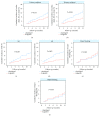Effects of Ticagrelor versus Clopidogrel in Patients with Coronary Bifurcation Lesions Undergoing Percutaneous Coronary Intervention
- PMID: 31016189
- PMCID: PMC6448338
- DOI: 10.1155/2019/3170957
Effects of Ticagrelor versus Clopidogrel in Patients with Coronary Bifurcation Lesions Undergoing Percutaneous Coronary Intervention
Abstract
Background: Percutaneous treatment of coronary bifurcation lesions can potentially lead to higher risk of ischemic events than the nonbifurcation ones, thus calling for further optimization of dual antiplatelet therapy (DAPT). This study aimed to compare the clinical outcomes from ticagrelor and clopidogrel in bifurcation lesions patients undergoing percutaneous coronary intervention (PCI).
Methods: We performed a retrospective cohort study in patients with coronary bifurcation lesions. A total of 553 patients discharged on ticagrelor or clopidogrel combined with aspirin were recruited for 1-year follow-up. The incidences of primary endpoint (major adverse cardiovascular event [MACE]: a composite of cardiac death, myocardial infarction [MI] or stroke), secondary endpoints (the individual component of the primary endpoint or definite/probable stent thrombosis), and major bleeding (Bleeding Academic Research Consortium [BARC]≥3 bleeding events) were evaluated. To minimize the selection bias, a propensity score-matched population analysis was also conducted.
Results: The risks of both primary endpoint (8.15% and 12.01% for the ticagrelor and clopidogrel groups, respectively; adjusted hazards ratio [HR]: 0.488, 95% confidence interval [CI]: 0.277-0.861, P=0.013) and MI (4.44% and 8.48% for the ticagrelor and clopidogrel groups, respectively; adjusted HR: 0.341, 95% CI: 0.162-0.719, P=0.005) were significantly reduced in the ticagrelor group as compared with those of the clopidogrel counterpart, whereas the risk of major bleeding was comparable (2.96% and 2.47% for the ticagrelor and clopidogrel groups, respectively; adjusted HR: 0.972, 95% CI: 0.321-2.941, P=0.960). Propensity score-matched analysis confirmed such findings.
Conclusions: For patients with bifurcation lesions after PCI, ticagrelor treatment shows lower MACE and MI rates than the clopidogrel one, along with comparable major bleeding.
Figures



Similar articles
-
Safety and Efficacy of Ticagrelor versus Clopidogrel in East Asian Patients with Acute Coronary Syndrome Undergoing Percutaneous Coronary Intervention Treated with Dual Antiplatelet Therapy: A Meta-Analysis of Randomized Controlled Trials.Cardiology. 2023;148(4):363-373. doi: 10.1159/000530602. Epub 2023 Apr 24. Cardiology. 2023. PMID: 37094558 Free PMC article.
-
Bleeding risk in patients prescribed dual antiplatelet therapy and triple therapy after coronary interventions: the ADAPTT retrospective population-based cohort studies.Health Technol Assess. 2023 May;27(8):1-257. doi: 10.3310/MNJY9014. Health Technol Assess. 2023. PMID: 37435838 Free PMC article.
-
Comparison of Net Clinical Benefit Between Clopidogrel and Ticagrelor Following Percutaneous Coronary Intervention in Patients in China With Acute Coronary Syndrome.Adv Ther. 2022 Jan;39(1):754-766. doi: 10.1007/s12325-021-01907-3. Epub 2021 Dec 13. Adv Ther. 2022. PMID: 34904209
-
Efficacy and safety of switching from ticagrelor to clopidogrel during the early and late phase in acute coronary syndrome patients after percutaneous coronary intervention.Platelets. 2020;31(3):337-343. doi: 10.1080/09537104.2019.1609668. Epub 2019 May 1. Platelets. 2020. PMID: 31043110
-
The Safety and Efficacy of Aspirin Discontinuation on a Background of a P2Y12 Inhibitor in Patients After Percutaneous Coronary Intervention: A Systematic Review and Meta-Analysis.Circulation. 2020 Aug 11;142(6):538-545. doi: 10.1161/CIRCULATIONAHA.120.046251. Epub 2020 Jun 19. Circulation. 2020. PMID: 32551860
Cited by
-
Influence of early dose reduction of ticagrelor on clinical outcomes following percutaneous coronary intervention for complex lesions.Sci Rep. 2023 Sep 19;13(1):15481. doi: 10.1038/s41598-023-42655-4. Sci Rep. 2023. PMID: 37726368 Free PMC article.
-
Left Main Disease and Bifurcation Percutaneous Coronary Intervention: Focus on Antithrombotic Therapy.US Cardiol. 2021 Jun 14;15:e11. doi: 10.15420/usc.2020.34. eCollection 2021. US Cardiol. 2021. PMID: 39720505 Free PMC article. Review.
-
Comparison of clopidogrel and ticagrelor in treating acute coronary syndrome undergoing PCI: A systematic review and meta-analysis.Heliyon. 2024 Feb 22;10(5):e26553. doi: 10.1016/j.heliyon.2024.e26553. eCollection 2024 Mar 15. Heliyon. 2024. PMID: 38455558 Free PMC article.
-
An Upfront Two-Stent Strategy for True Coronary Bifurcation Lesions with A Large Side Branch in Acute Coronary Syndrome: A Two-Year Follow-Up Study.Medicina (Kaunas). 2020 Feb 29;56(3):102. doi: 10.3390/medicina56030102. Medicina (Kaunas). 2020. PMID: 32121323 Free PMC article.
-
Ticagrelor Increases SIRT1 and HES1 mRNA Levels in Peripheral Blood Cells from Patients with Stable Coronary Artery Disease and Chronic Obstructive Pulmonary Disease.Int J Mol Sci. 2020 Feb 25;21(5):1576. doi: 10.3390/ijms21051576. Int J Mol Sci. 2020. PMID: 32106619 Free PMC article. Clinical Trial.
References
-
- Bangalore S., Amoroso N., Fusaro M., Kumar S., Feit F. Outcomes with various drug-eluting or bare metal stents in patients with st-segment-elevation myocardial infarction: A mixed treatment comparison analysis of trial level data from 34 068 patient-years of follow-up from randomized trials. Circulation: Cardiovascular Interventions. 2013;6(4):378–390. doi: 10.1161/CIRCINTERVENTIONS.113.000415. - DOI - PubMed
-
- Latib A., Colombo A. Bifurcation disease: what do we know, what should we do? JACC Cardiovasc Interv. 2008;1(3):218–226. - PubMed
MeSH terms
Substances
LinkOut - more resources
Full Text Sources
Miscellaneous

